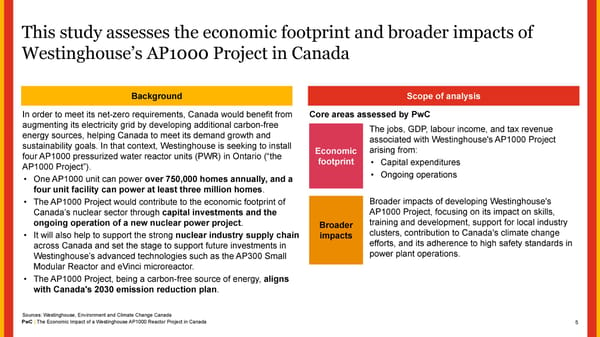This study assesses the economic footprint and broader impacts of Westinghouse’s AP1000 Project in Canada Background Scope of analysis In order to meet its net-zero requirements, Canada would benefit from Core areas assessed by PwC augmenting its electricity grid by developing additional carbon-free The jobs, GDP, labour income, and tax revenue energy sources, helping Canada to meet its demand growth and associated with Westinghouse's AP1000 Project sustainability goals. In that context, Westinghouse is seeking to install arising from: Economic four AP1000 pressurized water reactor units (PWR) in Ontario (“the footprint • Capital expenditures AP1000 Project”). • Ongoing operations • One AP1000 unit can power over 750,000 homes annually, and a four unit facility can power at least three million homes. Broader impacts of developing Westinghouse's • The AP1000 Project would contribute to the economic footprint of AP1000 Project, focusing on its impact on skills, Canada’s nuclear sector through capital investments and the training and development, support for local industry ongoing operation of a new nuclear power project. Broader clusters, contribution to Canada's climate change • It will also help to support the strong nuclear industry supply chain impacts efforts, and its adherence to high safety standards in across Canada and set the stage to support future investments in power plant operations. Westinghouse’s advanced technologies such as the AP300 Small Modular Reactor and eVinci microreactor. • The AP1000 Project, being a carbon-free source of energy, aligns with Canada's 2030 emission reduction plan. Sources: Westinghouse, Environment and Climate Change Canada PwC | The Economic Impact of a Westinghouse AP1000 Reactor Project in Canada 5
 The Economic Impact of a Westinghouse AP1000 Reactor Project in Canada Page 4 Page 6
The Economic Impact of a Westinghouse AP1000 Reactor Project in Canada Page 4 Page 6